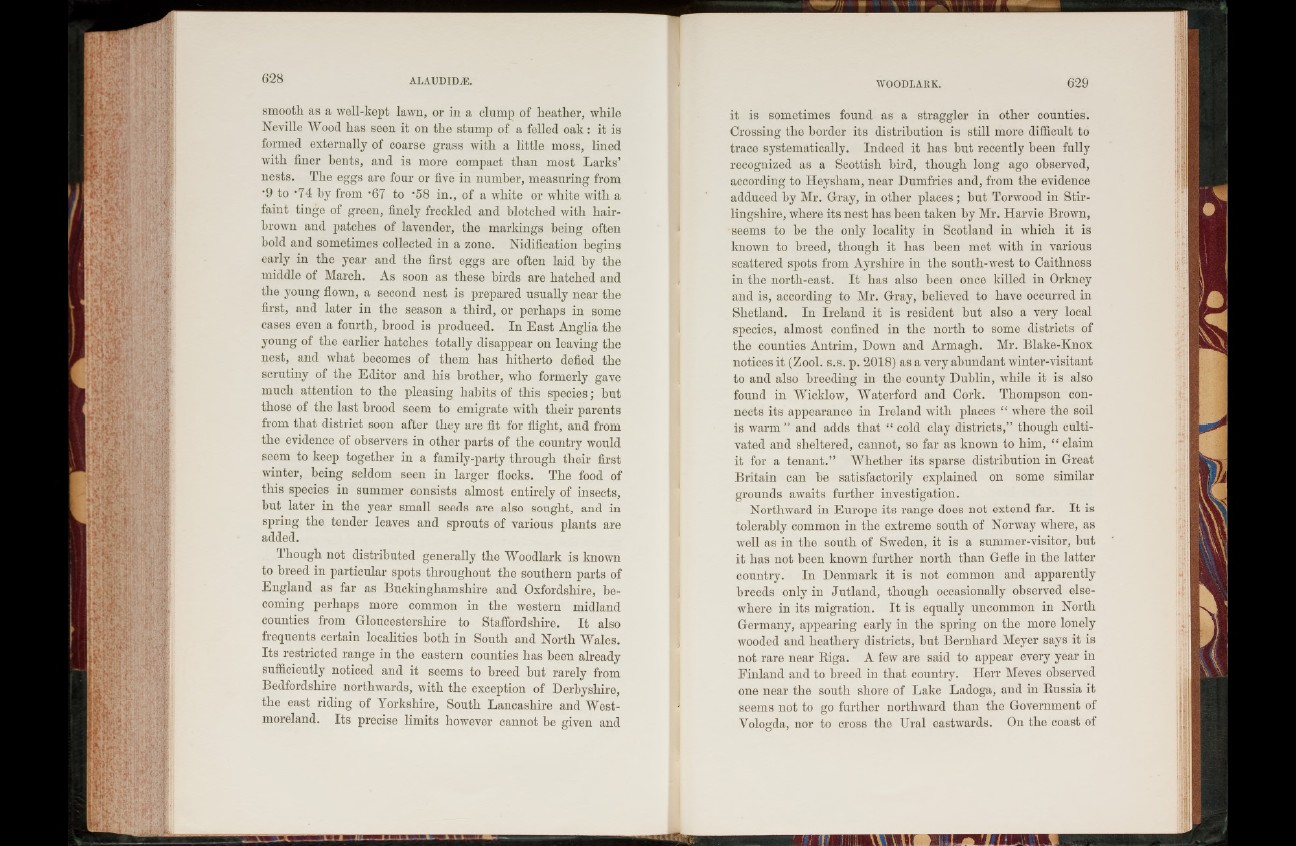
smooth as a well-kept lawn, or in a clump of heather, while
Neville Wood has seen it on the stump of a felled o ak : it is
formed externally of coarse grass with a little moss, lined
with finer bents, and is more compact than most Larks’
nests. The eggs are four or five in number, measuring from
•9 to -74 by from '67 to -58 in., of a white or white with a
faint tinge of green, finely freckled and blotched with liair-
hrown and patches of lavender, the markings being often
bold and sometimes collected in a zone. Nidification begins
early in the year and the first eggs are often laid by the
middle of March. As soon as these birds are hatched and
the young flown, a second nest is prepared usually near the
first, and later in the season a third, or perhaps in some
cases even a fourth, brood is produced. In East Anglia the
young of the earlier hatches totally disappear on leaving the
nest, and what becomes of them has hitherto defied the
scrutiny of the Editor and his brother, who formerly gave
much attention to the pleasing habits of this species; but
those of the last brood seem to emigrate with their parents
from that district soon after they are fit for flight, and from
the evidence of observers in other parts of the country would
seem to keep together in a family-party through their first
winter, being seldom seen in larger flocks. The food of
this species in summer consists almost entirely of insects,
but later in the year small seeds are also sought, and in
spring the tender leaves and sprouts of various plants are
added.
lliough not distributed generally the Woodlark is known
to breed in particular spots throughout the southern parts of
England as far as Buckinghamshire and Oxfordshire, becoming
perhaps more common in the western midland
counties from Gloucestershire to Staffordshire. I t also
frequents certain localities both in South and North Wales.
Its restricted range in the eastern counties has been already
sufficiently noticed and it seems to breed but rarely from
Bedfordshire northwards, with the exception of Derbyshire,
the east riding of Yorkshire, South Lancashire and Westmoreland.
Its precise limits however cannot be given and
it is sometimes found as a straggler in other counties.
Crossing the border its distribution is still more difficult to
trace systematically. Indeed it has but recently been fully
recognized as a Scottish bird, though long ago observed,
according to Heysham, near Dumfries and, from the evidence
adduced by Mr. Gray, in other places; but Torwood in Stirlingshire,
where its nest has been taken by Mr. Harvie Brown,
seems to be the only locality in Scotland in which it is
known to breed, though it has been met with in various
scattered spots from Ayrshire in the south-Avest to Caithness
in the north-east. I t has also been once killed in Orkney
and is, according to Mr. Gray, believed to have occurred in
Shetland. In Ireland it is resident but also a very local
species, almost confined in the north to some districts of
the counties Antrim, Down and Armagh. Mr. Blake-Knox
notices it (Zool. s.s. p. 2018) as a very abundant winter-visitant
to and also breeding in the county Dublin, Avhile it is also
found in WickloAV, Waterford and Cork. Thompson connects
its appearance in Ireland with places “ where the soil
is warm ” and adds that “ cold clay districts,” though cultivated
and sheltered, cannot, so far as known to him, “ claim
it for a tenant.” Whether its sparse distribution in Great
Britain can be satisfactorily explained on some similar
grounds awaits further investigation.
Northward in Europe its range does not extend far. I t is
tolerably common in the extreme south of Norway where, as
well as in the south of Sweden, it is a summer-visitor, but
it has not been known further north than Gefle in the latter
country. In Denmark it is not common and apparently
breeds only in Jutland, though occasionally observed elsewhere
in its migration. I t is equally uncommon in North
Germany, appearing early in the spring on the more lonely
wooded and heathery districts, but Bernhard Meyer says it is
not rare near Riga. A few are said to appear evrery year in
Finland and to breed in that country. Herr Meves observed
one near the south shore of Lake Ladoga, and in Russia it
seems not to go further northward than the Government of
Vologda, nor to cross the Ural eastwards. On the coast of